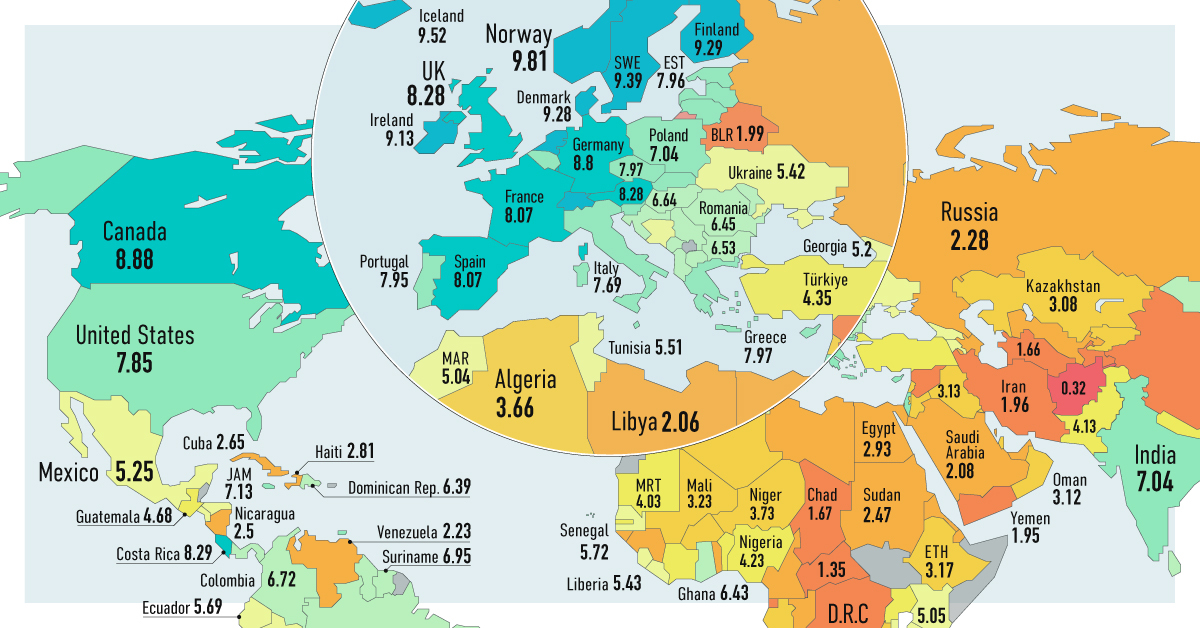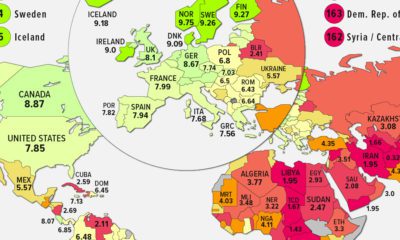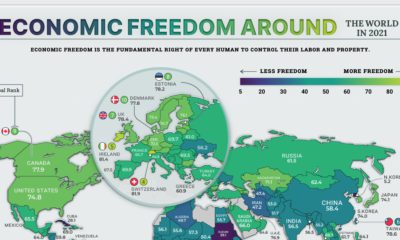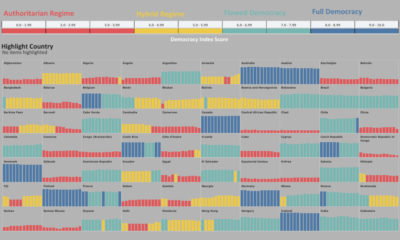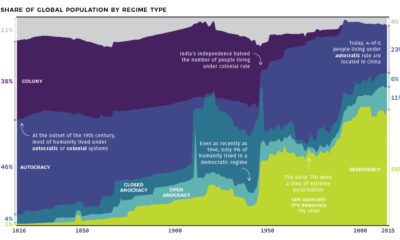Politics
Mapped: The State of Democracy Around the World
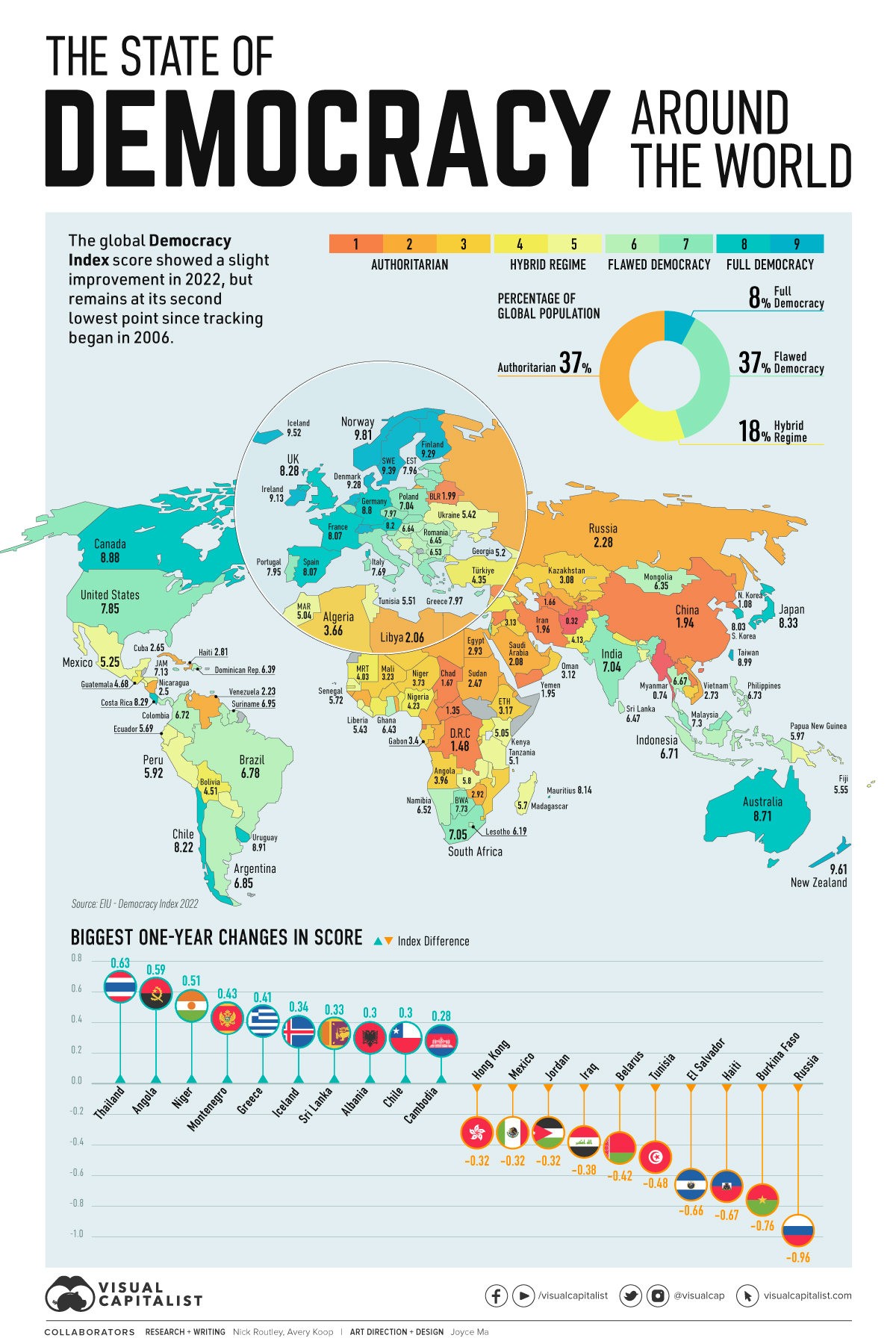
Mapped: The State of Democracy Around the World
Only 8% of the world’s population actually lives in a full, functioning democracy, according to the Economist Intelligence Unit (EIU).
Meanwhile, another 37% of people live in some type of “flawed democracy”, while 55% of the world does not live in democracy at all, based on the EIU’s latest Democracy Index Report.
Events such as the war in Ukraine and restrictive, long-lasting COVID-19 measures, have caused numerous declines to country democracy scores in recent years. Since the source report first began tracking scores in 2006, the global average has fallen from 5.52 to 5.29.
The Methodology
The EIU measures democracy by assessing 60 indicators across five key categories:
- Electoral process and pluralism
- Political culture
- Political participation
- Functioning of government
- Civil liberties
Each category has a rank of 0-10 based on how the indicators fared, and the overall democracy score is an average of each of the five categories. For example, here’s a look at the U.S.’ scoring out of 10 in each of the overall categories in 2022:
| Electoral process and pluralism | Functioning of government | Political participation | Political culture | Civil liberties |
|---|---|---|---|---|
| 9.17 | 6.43 | 8.89 | 6.25 | 8.53 |
🇺🇸 Total U.S. democracy score = 7.85 / 10
This score defines the U.S. as a flawed democracy and ranks it 30th overall in the world, down four spots from last year’s ranking. “Flawed” in this case simply means there are problems, ranging from poor political culture to governance issues, but flawed democracies are still considered to have free and fair elections, as well as civil liberties.
The World’s Democracies by Region
Below we map out the state of democracy across various regions around the world.
The Americas
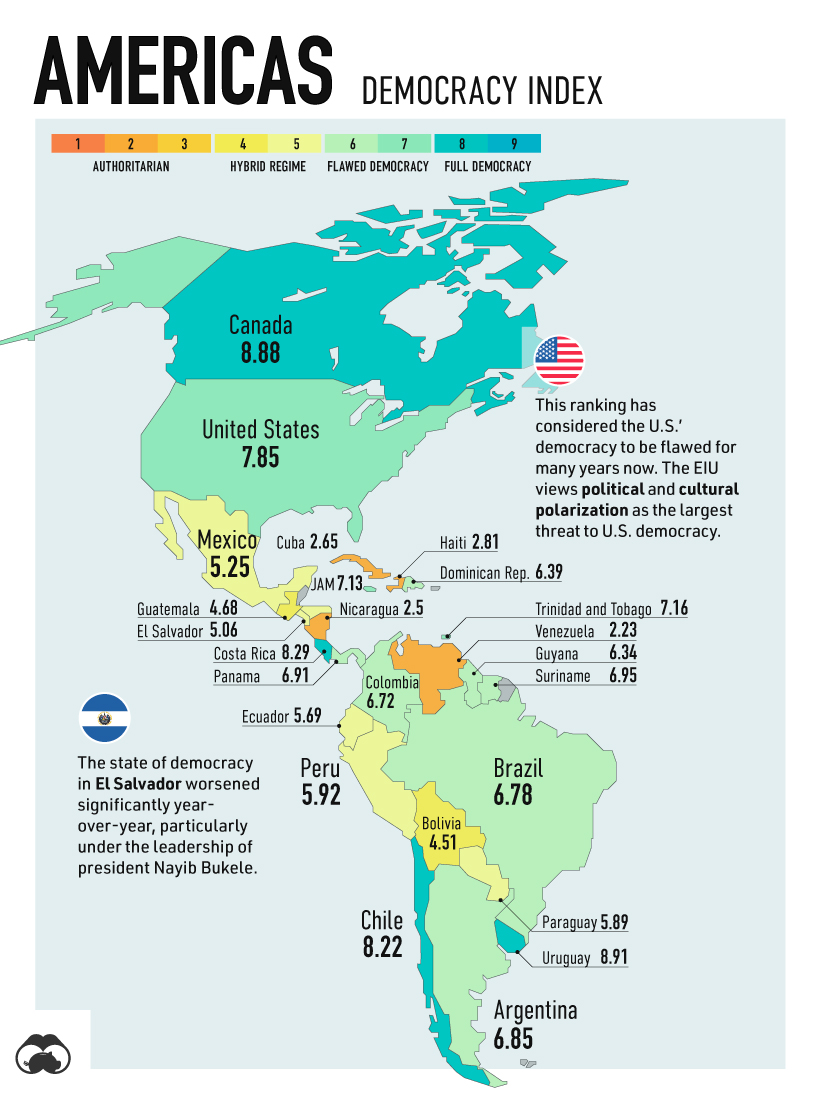
One of the best performers year-over-year was Chile, with its score increasing by nearly 0.3. The country moved out of the flawed democracy category last year, largely because of the shift towards constitutional reform alongside President Gabriel Boric moving towards the political center, reducing polarization.
Only three other countries in the Americas are also considered full democracies: Costa Rica, Canada, and Uruguay—the latter of which is #1 regionally.
On the flipside, some of the world’s worst performers year-over-year are located specifically in Latin America, namely: El Salvador and Haiti. Much of the low scores in the region are associated with high crime rates and corrupt governance.
Africa
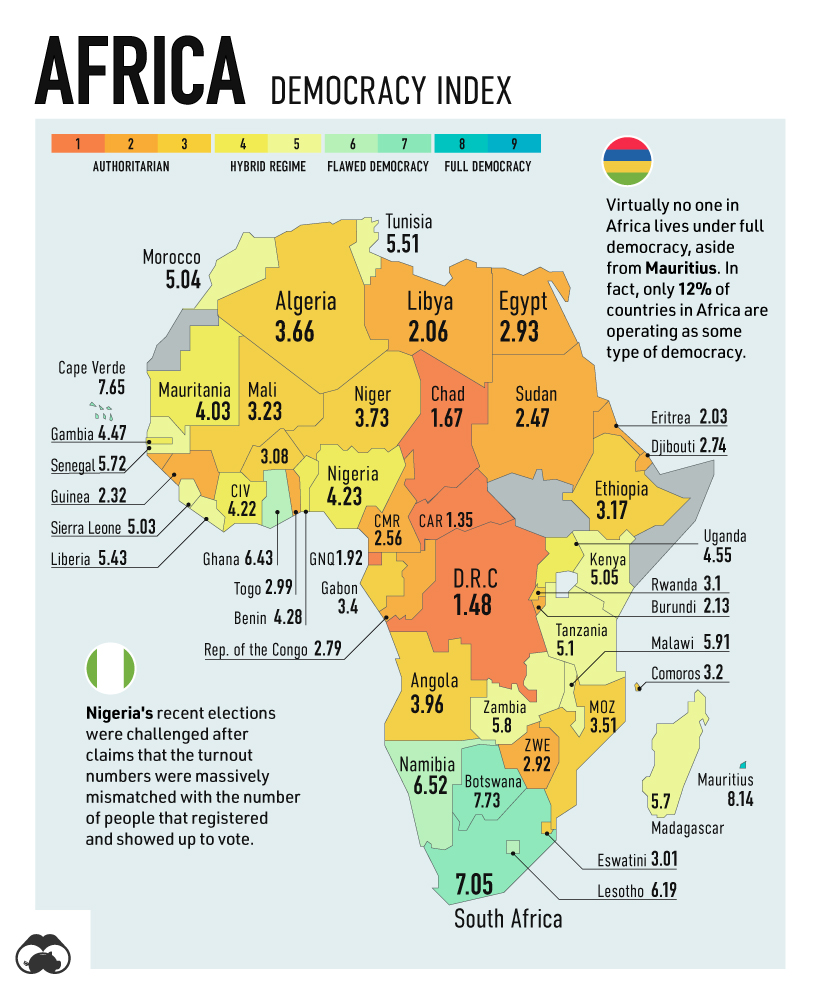
The only full democracy in Africa is the small, island nation of Mauritius. Overall, Africa is one of the lowest scoring regions with only five of the continent’s 54 countries ranking as some type of democracy.
Tunisia’s score decreased significantly in 2022. President Kais Saied dismissed parliament early in the year and took control of the electoral council, slowly shifting towards centralized power. And although there were critics, many have since been arrested, downgrading them in the EIU’s eyes from a flawed democracy to a hybrid regime.
Europe
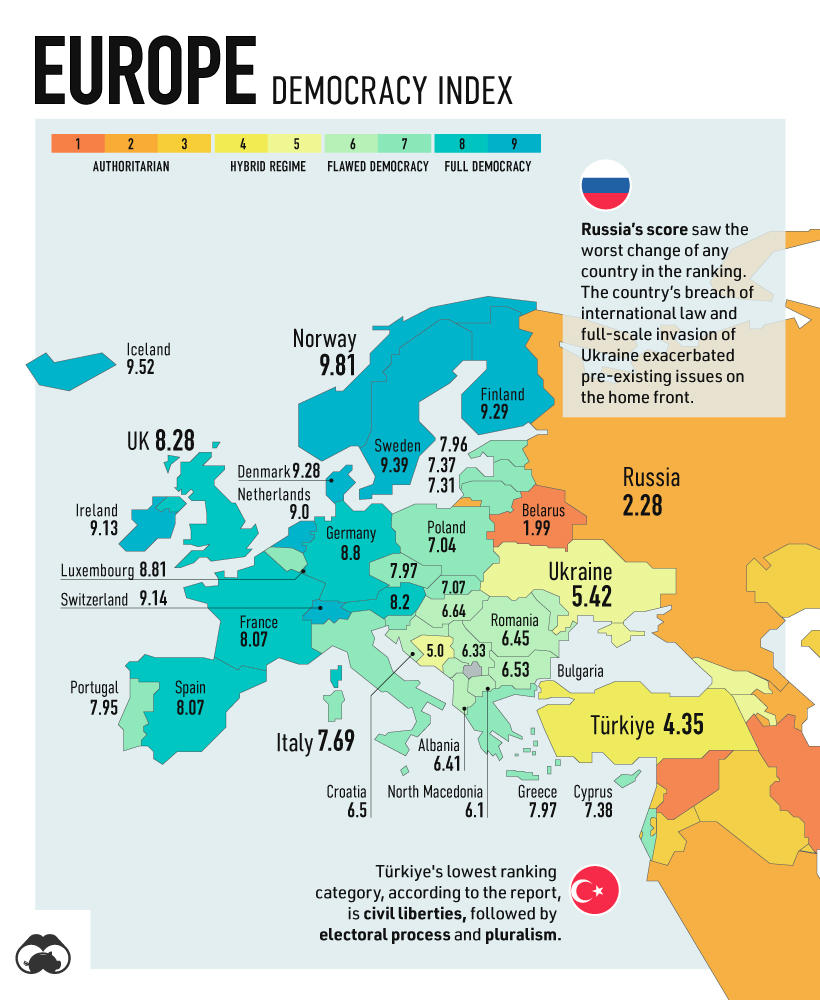
Spain and France regained status as full democracies in 2022, mainly improving in the civil liberties and functioning of government categories thanks to the easing of COVID-19 restrictions. However, both countries face political polarization; in Spain this is largely exemplified in the attitudes surrounding the Catalan separatist movement.
Some of the lowest scoring regimes in the region are in Russia and Belarus. Russia’s war in Ukraine has violated international law, as well as another country’s sovereignty, decimating its score by 0.96 in the index. Belarus has continually allied itself with Russia, allowing troops—and likely missiles—to enter Ukraine from its borders.
Oceania and East Asia
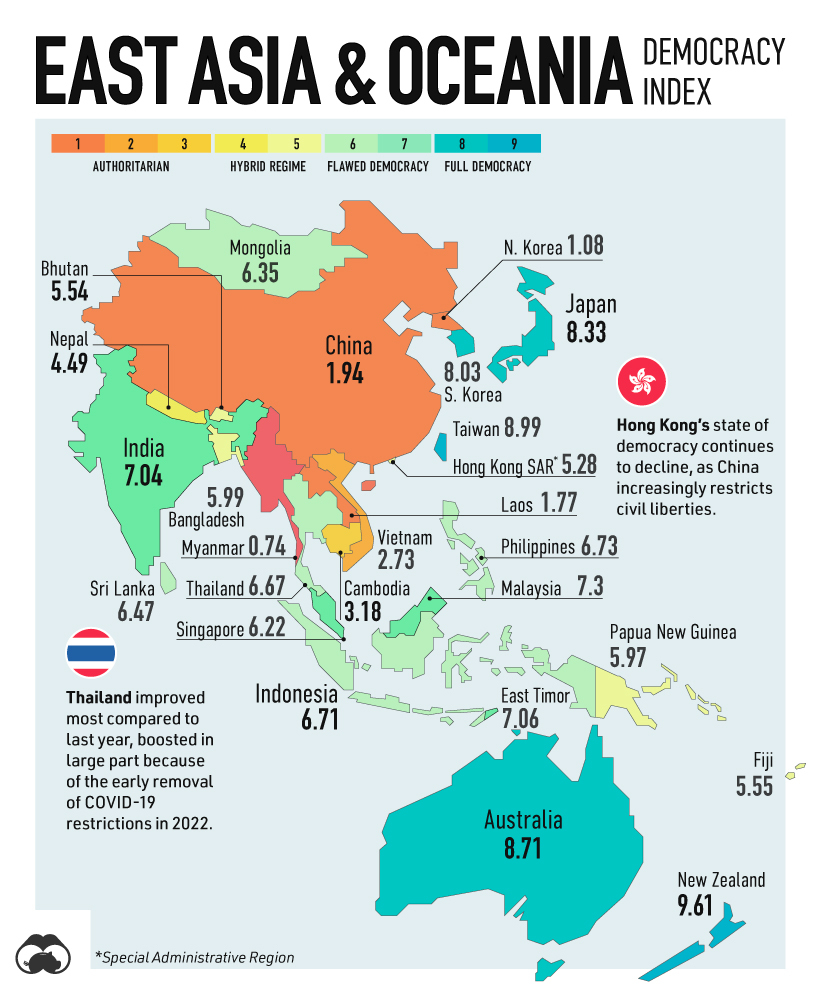
In this region, levels of democracy were severely affected by the COVID-19 pandemic. Hong Kong only removed restrictive policies like mask mandates in early 2023. In contrast, Thailand lifted these restrictions a year prior, providing more individual freedom, according to the report.
Malaysia’s fairly high score of 7.3 could face scrutiny, as the former Prime Minister, Muhyiddin Yassin, who was in office during COVID-19, is currently facing corruption charges for money laundering of COVID-19 stimulus package funds.
Central Asia and The Middle East
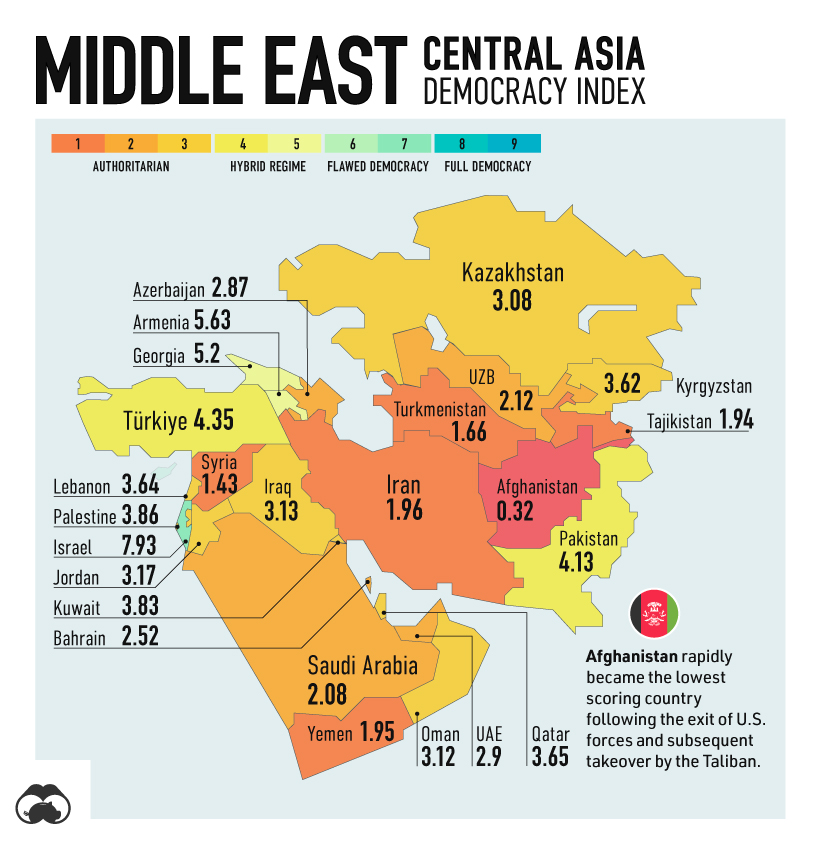
Finally, in the Middle East and Central Asia, there are no full democracies at all. The lowest scoring country globally is Afghanistan at only 0.32.
Israel, the only democracy of any kind of the region, actually moved down six spots in the global ranking from the year prior. Its lowest scoring category in 2022 was civil liberties. This year, the country is in the spotlight due to its judicial reforms proposed by the ruling nationalist party, and civil response has been strong. Mass protests continue around the country.
Where does this data come from?
Source: The Democracy Index Report by the Economist Intelligence Unit
Notes: This report, which has been produced by EIU since 2006, uses 60 indicators as well as public opinion polling and expert analysis to rank various countries. A detailed methodology can be found starting on page 66 of the report.
United States
Charted: What Southeast Asia Thinks About China & the U.S.
A significant share of respondents from an ASEAN-focused survey are not happy about rising American and Chinese influence in the region.

What Southeast Asia Thinks About China & the U.S.
This was originally posted on our Voronoi app. Download the app for free on iOS or Android and discover incredible data-driven charts from a variety of trusted sources.
This chart visualizes the results of a 2024 survey conducted by the ASEAN Studies Centre at the ISEAS-Yusof Ishak Institute. Nearly 2,000 respondents were asked if they were worried or welcoming of rising Chinese and American geopolitical influence in their country.
The countries surveyed all belong to the Association of Southeast Asian Nations (ASEAN), a political and economic union of 10 states in Southeast Asia.
Feelings Towards China
On average, a significant share of respondents from all 10 countries are worried about rising influence from both the U.S. and China.
However, overall skepticism is higher for China, at 74% (versus 59% for U.S.).
| Country | Worried About Growing 🇨🇳 Influence | Welcome Growing 🇨🇳 Influence |
|---|---|---|
| 🇧🇳 Brunei | 58% | 42% |
| 🇰🇭 Cambodia | 66% | 34% |
| 🇮🇩 Indonesia | 57% | 43% |
| 🇱🇦 Laos | 68% | 32% |
| 🇲🇾 Malaysia | 56% | 44% |
| 🇲🇲 Myanmar | 95% | 5% |
| 🇵🇭 Philippines | 81% | 19% |
| 🇸🇬 Singapore | 74% | 26% |
| 🇹🇭 Thailand | 84% | 16% |
| 🇻🇳 Vietnam | 96% | 4% |
| Average | 74% | 27% |
The recently-cooled but still active territorial concerns over the South China Sea may play a significant role in these responses, especially in countries which are also claimants over the sea.
For example, in Vietnam over 95% of respondents said they were worried about China’s growing influence.
Feelings Towards America
Conversely, rising American influence is welcomed in two countries with competing claims in the South China Sea, the Philippines (69%) and Vietnam (55%).
| Country | Worried About Growing 🇺🇸 Influence | Welcome Growing 🇺🇸 Influence |
|---|---|---|
| 🇧🇳 Brunei | 73% | 27% |
| 🇰🇭 Cambodia | 58% | 42% |
| 🇮🇩 Indonesia | 73% | 27% |
| 🇱🇦 Laos | 79% | 21% |
| 🇲🇾 Malaysia | 68% | 32% |
| 🇲🇲 Myanmar | 45% | 55% |
| 🇵🇭 Philippines | 32% | 69% |
| 🇸🇬 Singapore | 37% | 63% |
| 🇹🇭 Thailand | 80% | 20% |
| 🇻🇳 Vietnam | 45% | 55% |
| Average | 59% | 41% |
Despite this, on a regional average, more respondents worry about growing American influence (59%) than they welcome it (41%).
Interestingly, it seems almost every ASEAN nation has a clear preference for one superpower over the other.
The only exception is Thailand, where those surveyed were not a fan of either option, with 84% worried about China, and 80% worried about the U.S.
-

 Culture6 days ago
Culture6 days agoThe World’s Top Media Franchises by All-Time Revenue
-

 Science2 weeks ago
Science2 weeks agoVisualizing the Average Lifespans of Mammals
-

 Brands2 weeks ago
Brands2 weeks agoHow Tech Logos Have Evolved Over Time
-

 Energy2 weeks ago
Energy2 weeks agoRanked: The Top 10 EV Battery Manufacturers in 2023
-

 Countries2 weeks ago
Countries2 weeks agoCountries With the Largest Happiness Gains Since 2010
-

 Economy2 weeks ago
Economy2 weeks agoVC+: Get Our Key Takeaways From the IMF’s World Economic Outlook
-

 Demographics1 week ago
Demographics1 week agoThe Countries That Have Become Sadder Since 2010
-

 Money1 week ago
Money1 week agoCharted: Who Has Savings in This Economy?




